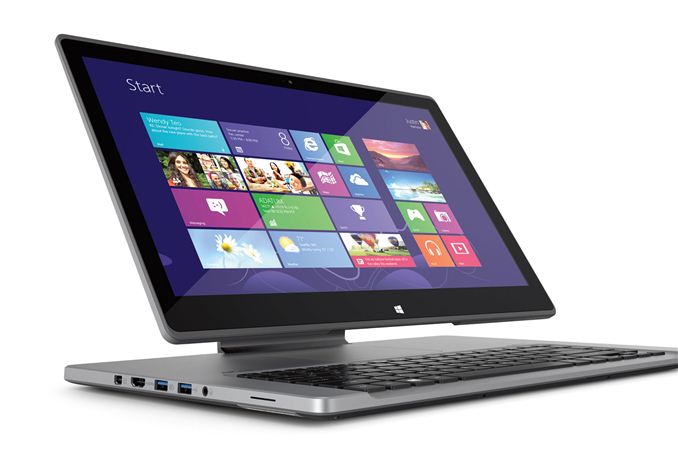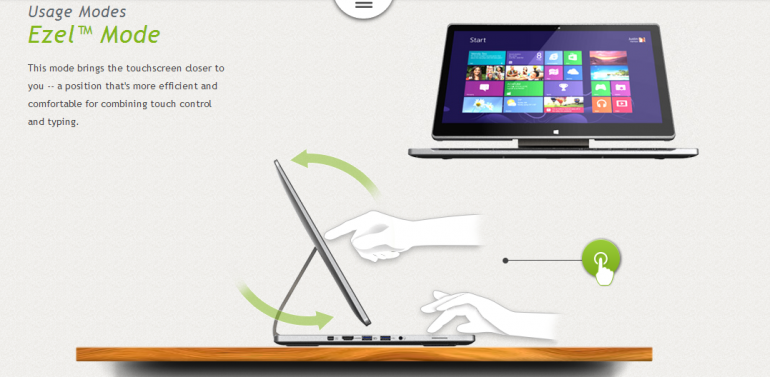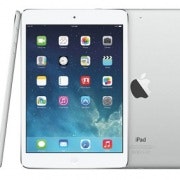REVIEW: Acer Aspire R7

It's not a great notebook, nor is it a great tablet. You'll need to find something else great about Acer's convertible Aspire R7 before you consider handing over your money.
You have to hand it to Acer, it's not afraid to try something different. The original Acer Iconia dual-screen notebook, with a second touchscreen instead of a physical keyboard, is one of the most intriguing yet impractical devices I've ever reviewed. This new 15.6-inch Aspire R7 -- which can't decide if it's a tablet, notebook or desktop replacement -- is certainly a worthy successor.
Let's not beat around the bush. I disliked the Aspire R7 as soon as I lifted the lid to discover that the trackpad is above the keyboard rather than below. It's like moving the steering wheel of your car into the back seat because it was spoiling the aesthetics of the dashboard.

First impressions are hard to shake when you're a tech reviewer. I tried my best to like the R7 but failed, especially once I took into account the hefty $2099 price tag. Having to stretch over the keyboard to reach the trackpad is an instant deal-breaker for me. I understand that a Windows 8 touchscreen device like this has less need for a trackpad, but that doesn't mean I'm prepared to turn my world upside down.
According to Acer's marketing guff; "Even the keyboard placement was reconsidered in the new design. Repositioning it closer to the body in front of the chassis makes typing more comfortable and as efficient and as fluid as possible. The keys fall naturally under the fingers, eliminating the need to hold the arms out and over the palm rest and touchpad in order to type."
This is, to use a technical term, absolute bullshit.
The redesign simply means you need to push the R7 further across the desk and away from your body, unless you want to type with your arms pinned up against your chest like a flailing T-Rex. Once you've pushed the notebook further away you realise the screen is now too far away, but that's when the Aspire R7 unleashes its hidden weapon -- the "Ezel" hinge. The screen actually lifts up on a hinge, letting you bring it upwards and forwards -- over the trackpad so the bottom of the screen rests where the keyboard starts. This is the reason why the trackpad is above the keyboard, as you lose access to the trackpad completely once you move the screen forward.

How you react to this surprise move depends on how you use your gadgets and what you want from the R7. If you're a fan of Windows 8 touchscreen tablets you might not be too fazed by the loss of the trackpad. My nine-year old son looked at the Aspire R7 and said, "it's got a touchscreen, so you don't even need the stupid trackpad". I generally don't tolerate such blasphemy in my home, but the lad makes a valid point.
If, like me, you're primarily looking for a notebook to work with the traditional Windows desktop, it's unlikely you're ready to sacrifice the trackpad completely. If, like my son, you're looking for a touchy-feely tablet style interface then you might not mourn the trackpad.
Even if you are looking for a tablet-style device you still might not be satisfied with the R7. The screen slides even further forward and tilts back down flat to cover the keyboard completely, but it still sits up on a slight angle. This is handy if you want to use the R7 as a desktop touchscreen device, at which point you might appreciate the supplied stylus. But if you pick up the R7 you're faced with an awkward and heavy tablet.
Alternatively you can place the R7 on the table and flip the screen over completely so it faces the person sitting opposite you, with the display automatically rotating to compensate. Some people might find this useful, such as financial advisors making house calls, but it will be simply a novelty for most people.
For me the best configuration is somewhere in between notebook and tablet, with the screen raised and tilted back slightly so it's easier to see but doesn't block access to the trackpad or keyboard. The keyboard looks and feels a little cramped, but it's actually the same size as the keyboard on my 15-inch MacBook Pro. It's simply the unusual placement which makes it feel awkward.
When raised on the hinge the screen remains surprisingly stable, even when you tap it firmly. Of course in this configuration you're still frustrated that the trackpad isn't where it belongs. After a while I found myself starting to favour the touchscreen over the trackpad, but only because the trackpad was still awkward to reach.
I haven't even addressed the R7's spec sheet but I'd say it's almost irrelevant. At this point you've already decided whether this is the one device you've been waiting for or another ill-considered failure in the pursuit of the perfect hybrid device. It's a 15.6-inch, 1920x1080 IPS-LED touchscreen notebook running Windows 8 on an dual-core 2 GHz Intel Core i7 processor with a very generous 12 GB of RAM. Under the bonnet you'll find a 24 GB solid state drive accompanied a traditional 1 TB hard drive for storage.
They're impressive specs but if you shop around you'll find notebooks which are just as powerful but cheaper and far more portable than this beast which tips the scales at 2.4 kg. At $2099 you're still paying a premium for the R7's design. If you don't like the design, you're wasting your money.
So what's the verdict? Acer's Aspire R7 is a textbook example of a solution in search of a problem. To dismiss it simply as an awkward notebook would seem to miss the point, as would to dismiss it as a cumbersome tablet. At its heart the Aspire R7 is some sort of a hybrid desktop replacement, but it's certainly not for everyone.
It's not that I don't like Windows 8. It's not that I don't like touchscreens. It's not even that I don't like hybrid convertibles. I simply don't like the Aspire R7 because it's bulky and expensive, with a poorly positioned trackpad and a fancy but mostly useless hinge. The longer I used it the more tolerable it became, but not to the point where I could actually see its merits over the alternatives.
It's like someone overhauled a notebook to add all these so-called great features which I never wanted -- like putting the steering wheel in the back seat. You'll need to make up your mind for yourself whether Acer's Aspire R7 offers the best of both worlds or the worst .















